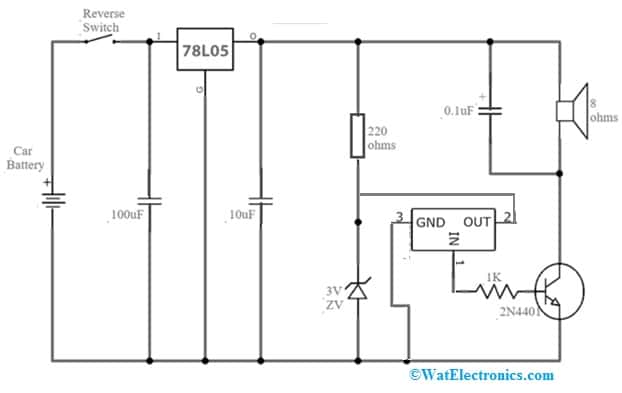A melody-generating IC is a type of chip that creates and generates melodies and plays music based on the program. It is a small and convenient melody generator chip that generates melodies & instrumental effects. So these are utilized in different devices like telephones, music boxes, toys, etc. Some melody generating ICs are; UM66T, dual tone melody generator IC, BT66, etc. This article elaborates on UM66 IC, pin-out, features, specifications, and applications.
What is UM66 IC?
UM66 IC is a melody generator IC available within the TO-92 package. So this plays five different tones depending on the version. This is a CMOS IC that utilizes very little power and it operates 1.5V to 4.5V supply voltage. This IC can be easily used to drive a 6/8 ohms rated speaker with an NPN transistor, thus used in bells, toys, doorbells, phones, alarm clocks, and many more. The UM66 IC includes an inbuilt beat and tone generator which plays a melody of up to 62 notes with an octave sound range.
The UM66 IC includes a 62-note ROM memory with a programmed divider that generates frequencies depending on the oscillator frequency. So the beat generator can also be a programmed divider including 15 available beats. This IC includes a power-on reset that creates the melody from the primary note whenever it is powered. This IC can also have a direct piezo drive that can be easily controlled with a set of 4 bits used for scale code and 2 2-bits for rhythm code.
How UM66 IC Works?
The UM66 melody generator IC produces electrical signals mainly for notes within a melody. So this IC operating voltage ranges from 1.5Volts to 3Volts where its supply voltage shouldn’t go beyond 3V otherwise it can get damaged.
Whenever the power supply is provided to UM66 IC resets and generates a melody current, thus, it doesn’t need any other electronic components to generate electrical signals for the melody notes at the output pin-3 of the IC. The output of this IC doesn’t have sufficient power to drive a speaker. So an NPN transistor is utilized as an amplifier. After that, the audio signal is provided to the base terminal of the transistor to enhance the signal enough to drive a loudspeaker.
Pin Configuration:
The UM66 IC pin configuration is shown below. This IC includes three pins which are explained below.

UM66 IC Pin Configuration
- Pin-1 (VCC): It is a voltage supply pin of IC.
- Pin-2 (GND): It is a ground pin of the melody generator IC.
- Pin-3 (Output): It is a melody output pin of the IC.
Features & Specifications:
The features and specifications of UM66 IC include the following.
- UM66 IC is a melody generator chip.
- It is available in a 3-pin TO-92 package.
- Its mounting style is Through a Hole.
- Its operating voltage ranges from 1.5Volts to 3Volts
- Current consumption is 1uA.
- It generates five different melody tones and each melody tone includes 64 notes.
- It can drive a speaker easily through an NPN transistor.
- It has a level-hold or one-shot mode to play melody repeatedly
- This IC has an RC oscillator.
- The sound range is 2 octaves.
- Tempo is 15 kinds.
- It has a direct piezo drive.
- The dynamic speaker is driven through an external NPN transistor.
- The operating current is 60μA.
- Its output drive current ranges from 400 to 600μA.
- The output sink current is 350 to 450μA.
- Frequency deviation is -12%
- Frequency stability is 10%.
- Its operating ambient temperature ranges from -10°C ~ +60°C.
- Its storage temperature ranges from -55°C ~ +125°C.
Equivalent & Alternatives:
Equivalent UM66 IC is BT66 IC. Alternative UM66 ICs are; UM3481, CIC2850, UM3481A, UM3561, UM66T11L, UM66T09S, UM66T11S, UM66T13S, UM66TXXS, UM66T13L, etc.
Amplifier Circuit with UM66 IC
Generally, there are different musical ICs available in the market like UM66, M3481, and UM3456, which are used as an indicator mainly for reversing cars, doorbells, vehicle turning indicators, intruder alarms, burglar alarms, etc.
Sometimes the sound from the musical IC is very slow so we are not able to listen to it properly because of the noise around your offices or home. Thus sound signal need to be amplified by using a simple amplifier circuit which amplifies the musical sound to properly hear it and also from a certain distance.
The amplifier circuit using UM66 IC is shown below. This circuit uses UM66 IC to amplify the musical sound. These sound signals can be amplified by using a very popular 8-pin LM386 audio amplifier IC which amplifies sound signals.
The required components to make this amplifier circuit mainly include; a +6V voltage supply, UM66 IC, LM386 IC, 3.3V zener diode, 10K variable resistor, 33E/2W resistor, capacitors 100uF, 1uF & 10uF, and a speaker. Connect this circuit as per the circuit diagram shown below.

Amplifier Circuit with UM66 IC
Working
This amplifier circuit working is very simple. Whenever power supply is applied to UM66 musical IC then it starts generating musical sound, so output can be received from pin-1 of this IC. A speaker is connected directly between pin-1 and GND so that musical sound can be heard. Here a Zener diode is connected at pin-2 of this IC because surplus voltage > 3.3V will damage the UM66 IC.
First, to amplify the signals, its gain factor needs to be adjusted through 1 & 8 pins. If it is left open then the gain will be 20dB because it is set internally within the IC however it can be changed by including a resistor & a capacitor in between pins 1 & 8 up to 200 dB.
The necessary signals now feed to pin-3 of LM386 IC. So a variable resistor can be connected to pin-3 of IC to correct the input signal’s sensitivity to get the output through pin-5. Thus, the C2 capacitor in this circuit works as a coupling capacitor that removes DC signals and only allows AC signals throughout it. Thus the amplified signals can be finally obtained through the speaker.
Car Reverse Alarm Circuit with UM66 IC
A simple car reverse alarm circuit using UM66 IC is shown below. The main function of this circuit is to generate a musical horn whenever the car is in reverse gear. So the required components to make this circuit mainly include; a battery, reverse switch, LM7805 voltage regulator, UM66 IC, 2N3904 transistor, 3V zener diode, 100µF, 10µF & 0.1µF electrolytic capacitors, 1K and 220Ω resistors and 8Ω speaker. Thus, connect this simple circuit as per the diagram shown below.

Car Reverse Alarm Circuit with UM66 IC
Working
This circuit works by using two ICs UM66 and LM78L05. So LM78L05 voltage regulator is used to regulate 8V fixed voltage to the circuit whereas the UM66 is a melody generator IC that produces a melody sound whenever it gets an input signal. Thus, the main purpose of using LM78L05 IC in this circuit is, that this circuit is operated with a 12V car battery and the circuit requires 8 volts only. So this voltage regulator IC will decrease the voltage to provide a fixed 8V voltage.
This car reverse alarm circuit is very simple to design and it consumes very little power. Whenever the car or vehicle goes into reverse gear the brake switch will be triggered and supply power to the circuit then it activates. The 12Volts is stepped down to 8V with LM78L05 voltage regulator. Further, this voltage can be stepped down from 5V to 3V through a Zener diode.
Here UM66 IC works with low power which is < 5 volts. So the UM66 IC gets the preferred input signal to produce a melody. Thus, this melody sound will be amplified throughout a transistor and after that, it is given to the 8 ohms speaker. So, this simple circuit can be utilized as a reverse horn mainly for any vehicle that utilizes a 12V battery.
Advantages & Disadvantages
The advantages of UM66 IC include the following.
- The UM66 IC is an easy-to-use melody generator chip.
- It has pre-programmed melodies, ease of integration, and low power consumption.
- It is easily integrated into circuit components or microcontrollers to make the design procedure simpler.
- This IC is reliable and durable.
- Its sound quality is rich.
- It includes a programmed divider that generates certain frequencies.
- Its 62-note ROM is useful for playing music.
- This IC has less power consumption.
- It is used in a wide range of applications.
The disadvantages of UM66 IC include the following.
- These melody generator ICs are fragile & cannot resist higher voltage operation.
- They have a limited rating of power.
- These can generate more noise throughout the operation.
- This IC cannot operate at high voltages.
- They have a limited power rating.
Applications
The applications of UM66 IC include the following.
- UM66 melody generator IC is used commonly in phones, calling bells, musical bells within doors, toys, burglar alarms, home security alarm systems, etc.
- It can be used in different places wherever you need to produce sirens and melodies.
- It is designed to utilize telephones, doorbells, bells, toys, and many more.
- This is used commonly in greeting cards where simple melody playback is necessary to create interactive & engaging experiences.
- This UM66 IC is used as an indicator for reversing cars mainly for vehicle turning indicators, intruder alarms, burglar alarms, etc.
Please refer to this link for the UM66 IC Datasheet.
Thus, this is an overview of UM66 IC, pin-out, features, circuits, working, pros, cons, and its applications. This IC has 6-bit of ROM which operates at different voltage levels from 1.5Volts to 4.5Volts. So this is a CMOS technology melody-generated IC that produces music that is utilized in different applications like telephones, doorbells, and toys. Thus, this IC includes an inbuilt ROM used for storing the melody data and low power consumption by the chip. Here is a question for you, what is UM3481 IC?